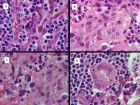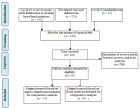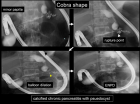About Charles University
Charles University
Articles by Charles University
‘Rotational alignment on patients’ clinical outcome of total knee arthroplasty: Distal femur axillary X-ray view to qualify rotation of the femoral component
Published on: 4th May, 2020
OCLC Number/Unique Identifier: 8588740322
Background: Rotation of the femoral component in total knee replacement (TKR) is very important for good long-term results. Malrotation of the femoral component usually requires subsequent reimplantation. We performed X-ray projections of the knee at 90° to determine proper rotation of the femoral component without use of computed tomography.
Methods: The axial projection of the distal femur was measured in post-TKR cases. During the TKR operation, Whiteside’s method had been used to provide symmetrical flexion space. The exact outer rotation of the femoral component was measured by x-ray determination of the middle condylar twist angle, from the central epicondylar axis and posterior condylar axis.
Results: The middle condylar twist angle was in outer rotation, with an average of 3.36° (range: 1-7.6), similar to the literature. Six of the patients underwent bilateral TKR. In total, the case series included 18 women and 15 men, with average age of 71.34 years-old (range: 56-85). As a clinical evaluation we used Knee Society Score (2011). From results 2 patients were not very satisfied with the instability TKR. Axially X-ray seemed to be only which could distribute these patients.
Summary: X-ray values have the same evaluation as computed tomography. The results were 2 patients in pattern of 48, which were sufficient to extrapolate to whole population according to the statistical methods. This corresponds to 4% which we can add to evaluate satisfaction of all patients after TKR and eventually lower the total of unsatisfactory patients which is total of ¼ of total. It is also forensic reason for all patients. Our recommendation to have good results and patient satisfaction in TKR is to do x-rays before and after operation. Important are x-rays antero-posterior, lateral, and Kanekasu projection to know the rotation after TKR. Other cases without stability in flexion are nor very rarely planed for revision surgery, which is much more expensive, and burdens overall health system.
Visualization and Evaluation of Changes after Rapid Maxillary Expansion
Published on: 30th March, 2017
OCLC Number/Unique Identifier: 7286430438
Objectives: The aim of the study was to develop a mathematical model for the visualization and evaluation of transversal palatal soft tissue changes; and to carry out a statistical evaluation of the changes in vertical and sagittal dimensions after rapid maxillary expansion treatment.
Material and Methods: 33 Caucasian children with posterior crossbite, 10 boys and 23 girls, aged 7 to 10 years (median 8 years 8 months) were treated with tooth-borne Haas type expander. Dental casts were digitalized by scanner and on the basis of quantitative mesh shape CPD-DCA analysis, coloured morphometrical maps were created. The statistical significance of individual vertex displacements was calculated by performing Hotelling’s T2 paired test. To determine the significance of the vertical and sagittal profile changes, the paired t-test and Wilcoxon signed rank test were carried out in 20 patients
Results: Visualization of the palatal soft tissue widening showed it to be greatest in the areas of the second deciduous and first permanent molars with maximum of 0.75 mm for each palatal side. Hotelling’s T2 paired test showed significant differences of p<0.01 in transversal width dimension. Cephalometric measurements of the changes to vertical and sagittal dimensions were statistically evaluated using the Wilcoxon and paired t-tests, and were shown to have insignificant values of p>0.05.
Conclusion: The expansion appliance in children resolved the crossbite and led to palatal widening, which was clearly visualized by creating mathematical morphometric models. The cephalometric measurements carried out did not reveal statistically significant relevance in changes to facial vertical or sagittal dimensions.
Anal cancer - impact of interstitial brachytherapy
Published on: 1st February, 2021
OCLC Number/Unique Identifier: 9039880199
We evaluated a total of 115 patients diagnosed with anal cancer, who were treated at our clinic from 1995 to 2012. Their average age was 61 years, most often were diagnosed in stages II and III, in most cases it was a squamous cell carcinoma located in the anal canal. The mean follow-up was 83 months (minimum 1 month and maximum 240 months). We combined external radiotherapy with boost of brachytherapy or boost of external radiotherapy and possibly a combination of both boosts. Half of the patients received concomitant chemotherapy. We specifically evaluated local tumor regression, overall survival and the impact to therapeutic effect of the chosen irradiation technique. Complete regression was achieved in 92 patients, partial regression in 21 patients. Overall survival, regardless of stage, was 80% 3-year, 74% 5-year and 67% 10-year. The age of patients, the size of their own primary tumor and the therapeutic method used had a statistically significant effect on survival - especially the importance of brachytherapy was irreplaceable.
Coronaryvirus infection, oxidative stress in ENT
Published on: 17th September, 2020
OCLC Number/Unique Identifier: 8671093042
In COVID-19 pandemic we focused on epidemiology and somewhat we neglect the possibility of biochemical influencing of the infection. Therefore we try to find some properties of the virus, which are impressionable by drugs. Droplet infection transmission is mainly (hypochloric acid) by nose and mouth. Diseases of nose and paranasal sinuses are most often of viral or bacterial origin.

HSPI: We're glad you're here. Please click "create a new Query" if you are a new visitor to our website and need further information from us.
If you are already a member of our network and need to keep track of any developments regarding a question you have already submitted, click "take me to my Query."
























































































































































